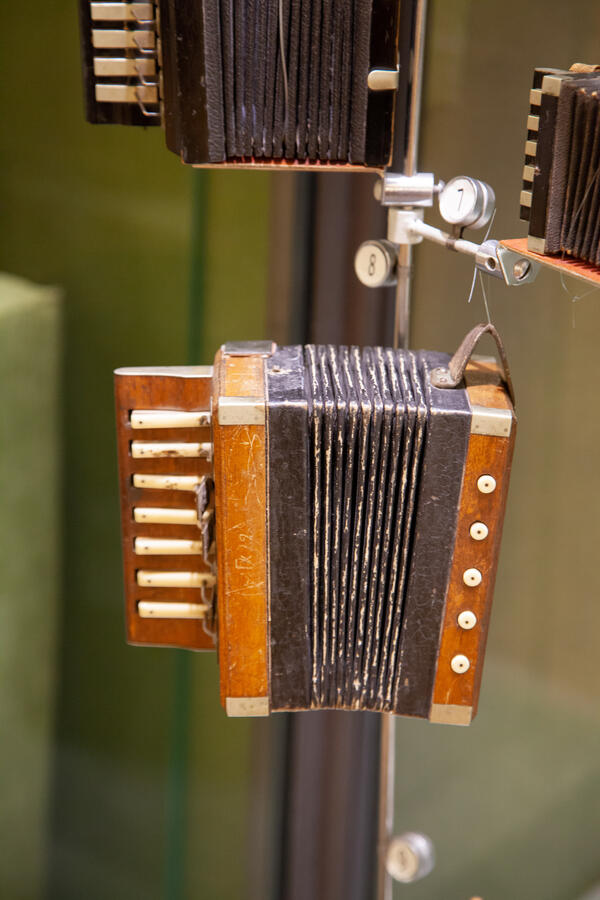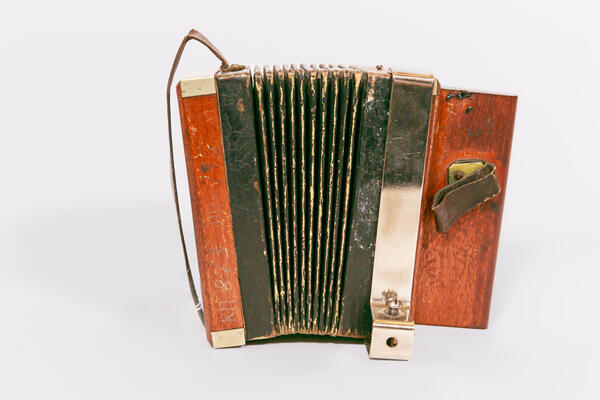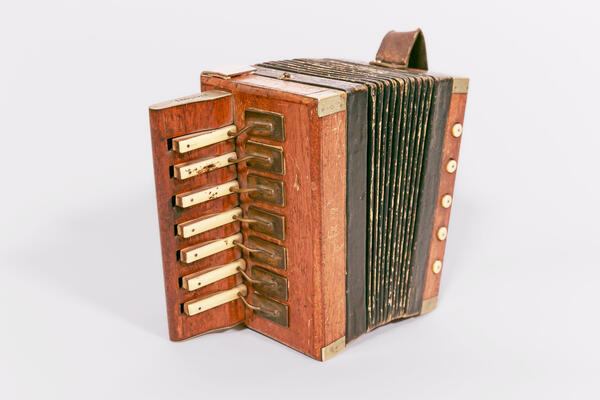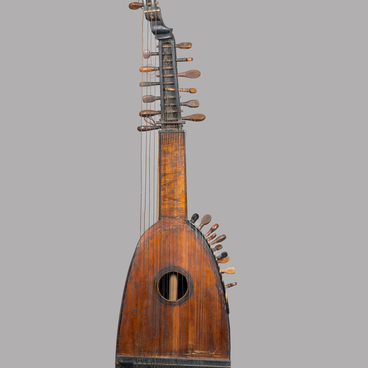In the 1930s, the museum received a small accordion that used to belong to Pyotr Yemelyanov, also known under the stage name of Pyotr Nevsky. The Cherepovets accordion was characterized by small size and the placement of the bass buttons on the instrument’s main body.
This chromatic instrument based on the design of Pyotr Nevsky has seven right-hand buttons and five left-hand buttons. In the 19th century, such instruments were sometimes called “acrobatic accordions” or “lilliput accordions, ” but they were mostly known under the name of “Cherepashkas, ” or “Little Turtles.” The reason behind the name was that the hands of musicians playing this small accordion looked like small turtle shells. This is why such miniature single-row accordions are still known as “Nevsky’s Little Turtles.”
Pyotr Nevsky was a Russian accordion player, ballad singer, songwriter, author of patter songs, dancer, and balalaika player. He performed on stage and delivered virtuoso performances playing small and miniature accordions.
The artist was born into a shoemaker’s family in Saint Petersburg in 1849. By the age of twenty, he learned to play the Tula accordion by ear. He began his career as an artist performing in the large trading towns of the Volga region. His life was changed forever when he met a circus troupe of the Yurovs, the world-famous eccentric musicians.
Pyotr Nevsky achieved great success touring Turkey, Belgium, Czechia, Poland, Germany, England, France, and Monaco. After returning to Russia, Nevsky presented a new musical number “The Journey Through Europe.” He sang humorous verses about European cities, with audiences roaring with laughter the entire time. The last verse ended with the lines “Travel East and travel West, the Russian land is still the best.”
Nevsky achieved nationwide popularity. His repertoire included original arrangements of pieces by Mikhail Ivanovich Glinka, Pyotr Ilyich Tchaikovsky, and Giuseppe Verdi. In 1896, Pyotr Nevsky was invited to the coronation of Nicholas II.
The museum houses eight phonograph wax cylinders with performances by Pyotr Nevsky. In 1898, he recorded medleys, verses, sayings, and his own original waltz “Ten Sounds.”
This chromatic instrument based on the design of Pyotr Nevsky has seven right-hand buttons and five left-hand buttons. In the 19th century, such instruments were sometimes called “acrobatic accordions” or “lilliput accordions, ” but they were mostly known under the name of “Cherepashkas, ” or “Little Turtles.” The reason behind the name was that the hands of musicians playing this small accordion looked like small turtle shells. This is why such miniature single-row accordions are still known as “Nevsky’s Little Turtles.”
Pyotr Nevsky was a Russian accordion player, ballad singer, songwriter, author of patter songs, dancer, and balalaika player. He performed on stage and delivered virtuoso performances playing small and miniature accordions.
The artist was born into a shoemaker’s family in Saint Petersburg in 1849. By the age of twenty, he learned to play the Tula accordion by ear. He began his career as an artist performing in the large trading towns of the Volga region. His life was changed forever when he met a circus troupe of the Yurovs, the world-famous eccentric musicians.
Pyotr Nevsky achieved great success touring Turkey, Belgium, Czechia, Poland, Germany, England, France, and Monaco. After returning to Russia, Nevsky presented a new musical number “The Journey Through Europe.” He sang humorous verses about European cities, with audiences roaring with laughter the entire time. The last verse ended with the lines “Travel East and travel West, the Russian land is still the best.”
Nevsky achieved nationwide popularity. His repertoire included original arrangements of pieces by Mikhail Ivanovich Glinka, Pyotr Ilyich Tchaikovsky, and Giuseppe Verdi. In 1896, Pyotr Nevsky was invited to the coronation of Nicholas II.
The museum houses eight phonograph wax cylinders with performances by Pyotr Nevsky. In 1898, he recorded medleys, verses, sayings, and his own original waltz “Ten Sounds.”






